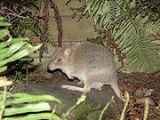
Eastern Bettong
Encyclopedia
The Eastern Bettong also known as the Southern Bettong and Tasmanian Bettong, is a bettong
whose natural range includes south-eastern Australia
and the eastern part of Tasmania
. Following the introduction of the red fox
, it became extinct on mainland Australia around 1890.
. During the day it sleeps in a nest it constructs out of grasses and leaves. A major component of its diet is underground fungi related to truffles, but it is also happy to dig up root
s and tuber
s as well. Insects and grubs are also eaten when encountered. It is unique in that it will travel up to 1.5 km from its nest to a feeding area, which is a considerable distance for a creature that rarely exceeds 2 kg in mass.
This bettong's habitat is open woodlands at altitudes between sea-level and 1000 m. (The highest point on Tasmania is at 1617 m.) The bettong usually nests in dry open eucalypt forests and grassy woodlands, sleeping during the day in a domed, grass nest that is well camouflaged and built by collecting nesting material bundled and transported to it in its curved prehensile tail.
Like other bettongs, the Eastern Bettong is a continuous breeder with a gestation period of only three weeks. They produce young all year.
es to Tasmania is a major threat to this population.. The International Union for the Conservation of Nature has raised the threat status for Eastern Bettongs from Least Concern to Near Threatened based on the threat from foxes.
Bettong
The bettongs are species of the genus Bettongia, sometimes referred to as rat-kangaroos. Five species are recognised:* Eastern Bettong, Bettongia gaimardi* Boodie, Bettongia lesueur...
whose natural range includes south-eastern Australia
Australia
Australia , officially the Commonwealth of Australia, is a country in the Southern Hemisphere comprising the mainland of the Australian continent, the island of Tasmania, and numerous smaller islands in the Indian and Pacific Oceans. It is the world's sixth-largest country by total area...
and the eastern part of Tasmania
Tasmania
Tasmania is an Australian island and state. It is south of the continent, separated by Bass Strait. The state includes the island of Tasmania—the 26th largest island in the world—and the surrounding islands. The state has a population of 507,626 , of whom almost half reside in the greater Hobart...
. Following the introduction of the red fox
Red Fox
The red fox is the largest of the true foxes, as well as being the most geographically spread member of the Carnivora, being distributed across the entire northern hemisphere from the Arctic Circle to North Africa, Central America, and the steppes of Asia...
, it became extinct on mainland Australia around 1890.
Diet and Behaviour
The Eastern Bettong is a nocturnal animalNocturnal animal
Nocturnality is an animal behavior characterized by activity during the night and sleeping during the day. The common adjective is "nocturnal"....
. During the day it sleeps in a nest it constructs out of grasses and leaves. A major component of its diet is underground fungi related to truffles, but it is also happy to dig up root
Root
In vascular plants, the root is the organ of a plant that typically lies below the surface of the soil. This is not always the case, however, since a root can also be aerial or aerating . Furthermore, a stem normally occurring below ground is not exceptional either...
s and tuber
Tuber
Tubers are various types of modified plant structures that are enlarged to store nutrients. They are used by plants to survive the winter or dry months and provide energy and nutrients for regrowth during the next growing season and they are a means of asexual reproduction...
s as well. Insects and grubs are also eaten when encountered. It is unique in that it will travel up to 1.5 km from its nest to a feeding area, which is a considerable distance for a creature that rarely exceeds 2 kg in mass.
This bettong's habitat is open woodlands at altitudes between sea-level and 1000 m. (The highest point on Tasmania is at 1617 m.) The bettong usually nests in dry open eucalypt forests and grassy woodlands, sleeping during the day in a domed, grass nest that is well camouflaged and built by collecting nesting material bundled and transported to it in its curved prehensile tail.
Like other bettongs, the Eastern Bettong is a continuous breeder with a gestation period of only three weeks. They produce young all year.
Threats
While the mainland population became extinct in the final years of the 19th century, the Tasmanian population has been regarded as secure. One concern is that most of the bettongs are found on private land, with only two groups found within reserves. The introduction of red foxRed Fox
The red fox is the largest of the true foxes, as well as being the most geographically spread member of the Carnivora, being distributed across the entire northern hemisphere from the Arctic Circle to North Africa, Central America, and the steppes of Asia...
es to Tasmania is a major threat to this population.. The International Union for the Conservation of Nature has raised the threat status for Eastern Bettongs from Least Concern to Near Threatened based on the threat from foxes.

